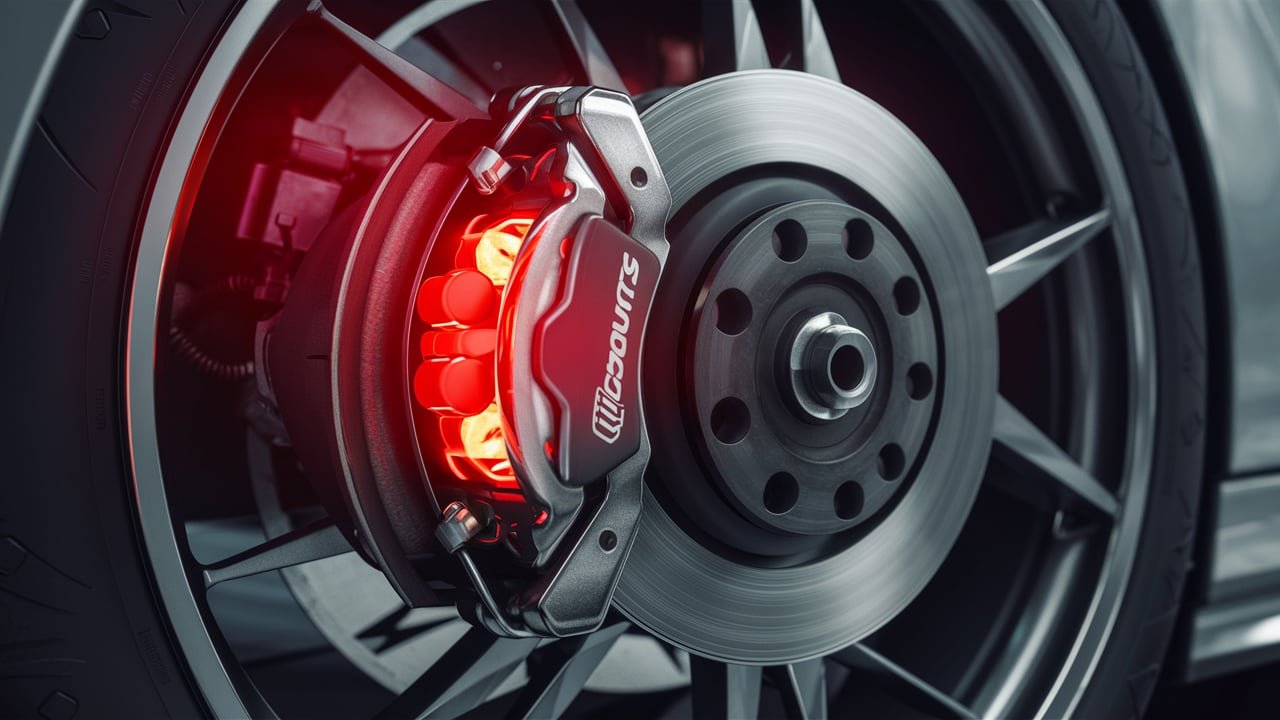
8 Essential Things You Need to Know About Your Vehicle’s Braking System
A vehicle’s braking system is a critical component that ensures safety and control while driving. It transforms kinetic energy into heat through friction, slowing down or stopping the vehicle. The braking system consists of several key components:
Components.
- Master Cylinder: Receives hydraulic fluid from a reservoir and transmits pressure to the brake lines.
- Brake Lines: Carry hydraulic fluid from the master cylinder to the wheel cylinders.
- Wheel Cylinders: Convert hydraulic pressure into mechanical force to engage brake pads.
- Brake Pads: Press against the brake discs or drums to generate friction.
- Brake Discs or Drums: The surfaces that the brake pads press against to slow down the vehicle.
Types of Braking Systems.
- Disc Braking System: Uses a disc or rotor attached to the wheel, which is clamped by brake pads to generate friction.
- Drum Braking System: Utilizes friction between brake shoes and the inner surface of a drum-shaped component attached to the wheel.
- Regenerative Brake System: Converts kinetic energy into electrical energy, primarily used in hybrid and electric vehicles.
- Anti-lock Braking System (ABS): Prevents wheels from locking up during emergency braking by adjusting hydraulic pressure to each brake independently.
Functions and Principles.
- Friction Principle: The primary principle behind the braking system is friction, which converts kinetic energy into thermal energy.
- Heat Dissipation Principle: Brake rotors are designed to dissipate heat generated during braking to prevent overheating.
- Hydraulic Principle: The braking system operates on the principle of hydraulics, amplifying a small force on the brake pedal into a larger force at the brakes.
Importance.
- Safety: An efficient braking system is essential to avoid crashes and stop the car safely in emergency situations.
- Control: Brakes allow the driver to maintain control over the vehicle, especially in intense traffic situations or adverse weather conditions.
- Maintenance: Regular maintenance is crucial to ensure optimal performance and prevent premature wear of components.
Key Brands.
- Sadeca: A leading company in brake components manufacturing with a focus on innovation and quality.
- FRENKIT: A Spanish brand specialized in brake repair kits and related components.
- Autofren Seinsa: A company devoted to manufacturing high-quality brake components.
- Icer Brakes: A well-known company worldwide for its innovative braking systems.
Recent Developments.
- ABS: Became standard on many passenger cars in the late 1980s, providing improved safety and control during braking.
- Regenerative Brake Systems: Used in hybrid and electric vehicles to harness kinetic energy and reduce waste heat.
The braking system is a critical component of a vehicle, ensuring safety and control. Understanding its components, principles, and functions helps drivers appreciate its importance and prioritize regular maintenance to ensure optimal performance and safety on the road.
In the intricate dance of automotive safety, few elements are as vital as a vehicle’s braking system. Seldom observed yet ever crucial, the braking system stands as a silent guardian against unforeseen perils on the road.
Within this mechanical ensemble lie key components meticulously crafted to halt tons of metal hurtling through space with precision and efficiency. Understanding its nuances isn’t merely an academic exercise but a prerequisite for every driver keen on safe passage amidst the bustle of asphalt arteries.
Enter the realm where rotors spin in harmonious rhythm with brake pads, orchestrating a symphony of deceleration. Disciplined control emanates from hydraulic systems that transmit motions from pedal to caliper, transforming kinetic energy into stillness in calculated increments.
The substance coursing through these veins—brake fluid—serves as the lifeblood that ensures seamless operation within this complex network. As drivers navigate roads bustling with uncertainties, the resilience and fidelity of their braking systems take center stage in sculpting a narrative where safety reigns supreme amidst vehicular endeavors.
Understanding the Basics of Brakes.
Brakes are one of the most crucial safety components in any vehicle, responsible for slowing down or stopping the vehicle when needed. When you press the brake pedal, a series of actions are set in motion to convert your car’s kinetic energy into heat energy, ultimately reducing its speed.
Two primary types of braking systems used in vehicles are disc brakes and drum brakes. Disc brakes, commonly found on the front wheels, work by using calipers to squeeze brake pads against a rotor connected to the wheel hub. On the other hand, drum brakes operate by pushing brake shoes against the inside surface of a rotating drum affixed to the wheel.
Regular inspections and maintenance are imperative factors in ensuring that your vehicle’s braking system performs optimally. Over time, wear and tear can affect various components like brake pads, rotors, and calipers.

Routine checks can help identify issues early on and prevent potential risks while driving. Moreover, maintaining proper brake fluid levels is essential as it plays a critical role in transmitting force from the pedal to activate the brakes efficiently.
By understanding how different types of brakes work and recognizing their maintenance needs, you empower yourself with knowledge that enhances your vehicle’s safety on the road. Consider this scenario: as you approach a red light at an intersection, knowing how your disc brakes function gives you confidence in applying appropriate pressure on the pedal for a smooth stop.
Regularly checking for signs of wear or unusual sounds during braking allows you to address emerging problems promptly before they escalate into more serious issues. Remember that well-maintained brakes contribute significantly to safe driving practices and overall vehicle longevity.
Signs of Brake Wear and Potential Issues.
Recognizing the signs of brake wear is crucial for maintaining a vehicle’s braking system in optimal condition. One common indicator of deteriorating brakes is the presence of a high-pitched squealing noise when applying the brakes.
This sound is often caused by brake pads that have worn down, allowing a metal wear indicator to come into contact with the rotor. Additionally, a grinding noise can signify significant brake pad depletion, leading to potential damage to other components like the rotors. When ignored, these noises can escalate into more severe problems.
Another red flag hinting at potential brake system issues is experiencing vibrations or pulsations when slowing down the vehicle. These vibrations could indicate warped brake rotors due to excessive heat buildup from prolonged or intense braking sessions, compromising braking efficiency.

Moreover, if your vehicle pulls to one side when braking instead of stopping straight, it might be attributed to uneven brake pad wear or issues with calipers. Such asymmetrical behavior demands immediate attention to prevent further safety risks on the road and avoid uneven tire wear as well.
Addressing brake issues promptly is paramount in ensuring both driver safety and preventing costly repairs down the line. Delaying necessary maintenance or neglecting warning signs not only compromises the effectiveness of your vehicle’s braking system but also heightens the risk of accidents.
By being vigilant about these telltale signs and taking preemptive action, drivers can maintain their brakes’ performance and extend their longevity while enhancing overall road safety for themselves and others. Remember, proactive care saves you from reactive consequences when it comes to your vehicle’s braking system maintenance.
Importance of Brake Fluid and its Maintenance.
Brake fluid is a fundamental component of your vehicle’s braking system, playing a crucial role in transferring the pressure from the brake pedal to the brake components.
This hydraulic fluid operates under high temperatures and pressures, allowing efficient operation of the brakes when you need to slow down or stop your vehicle. Without adequate brake fluid, your brakes would fail to engage properly, compromising your safety on the road.
One key indicator of low or contaminated brake fluid is a spongy or unresponsive brake pedal. When air enters the brake lines or moisture contaminates the fluid, it can lead to decreased braking performance and potential safety hazards. Additionally, discolored or murky brake fluid signifies contamination and should prompt immediate attention to prevent damage to braking components.
Regular checks and flushes of your vehicle’s brake fluid are paramount for ensuring optimal braking efficiency. Over time, brake fluid absorbs moisture and becomes less effective at transmitting hydraulic pressure.
By adhering to manufacturer-recommended maintenance schedules for changing brake fluid, you can maintain peak braking performance and extend the lifespan of critical braking system components like calipers and hoses. Remember that proper maintenance of your car’s brake fluid is as essential as monitoring wear on brake pads to guarantee safe driving experiences.
The Role of Brake Pads and Rotors.
Brake pads and rotors play a crucial role in the vehicle’s braking system by providing the friction necessary to slow down or stop a moving vehicle safely. When you press the brake pedal, hydraulic pressure is applied to squeeze the brake pads against the rotor, creating enough friction to reduce the vehicle’s speed.
\The consistent performance of brake pads and rotors ensures effective braking each time you need to decelerate or come to a stop. By understanding how these components work together, drivers can appreciate the importance of keeping them well-maintained for optimal performance.
It is essential to pay attention to indicators that signal when it is time to replace brake pads or rotors. High-pitched squealing noises while braking, vibrations felt through the brake pedal, or decreased stopping power are common signs of worn-out brake pads.

Similarly, grooves, scoring, or warping on the surface of rotors indicate their diminished effectiveness. Ignoring these warning signs can lead to more severe issues like damage to other braking components or compromised safety on the road. Regular visual inspections and addressing any potential problems promptly can prevent costly repairs down the line.
To extend the lifespan of brake pads and rotors, drivers can adopt proper driving habits that reduce unnecessary wear and tear on these components. Avoiding sudden stops or aggressive braking whenever possible helps preserve the integrity of both brake pads and rotors.
Additionally, maintaining a safe following distance on the road allows for smoother braking transitions, reducing strain on these critical elements of your vehicle’s braking system. By being mindful of how driving behaviors impact brake wear, motorists can enhance both their safety and the longevity of their braking system with simple adjustments in driving techniques.
Upgrading your vehicle’s braking system.
Upgrading your vehicle’s braking system can significantly enhance your driving experience and safety on the road. One of the key benefits of upgrading to high-performance brake components is improved stopping power and responsiveness.
Upgraded brakes are designed to handle higher temperatures more efficiently, reducing brake fade during aggressive or repeated braking maneuvers. This is particularly beneficial for drivers who engage in spirited or performance driving where standard brakes may struggle to keep up with the demands placed on them.
For example, upgrading to performance brake pads and rotors can make a noticeable difference in overall braking performance, allowing for quicker stops and better control.
When considering upgrading your brakes, several factors should be taken into account to ensure compatibility and optimal performance. Firstly, it’s crucial to match the upgraded components with the intended use of your vehicle.
For instance, if you regularly tow heavy loads or drive in mountainous terrain, you may need heavy-duty brakes that can withstand increased heat generation. Additionally, factor in your driving habits and conditions in which you typically drive – street driving versus track days will have different requirements for brake setups.
Consulting with automotive professionals or enthusiasts can provide valuable insight into choosing the right components tailored to your specific needs.

The decision between professional installation and DIY upgrades when enhancing your braking system depends on various factors. While skilled DIYers may opt for self-installation to save on labor costs and enjoy the satisfaction of completing the upgrade themselves, professional installation ensures precision fitment and adherence to manufacturer specifications.
DIY upgrades require access to specialized tools and expertise and involve certain risks if not executed correctly, potentially compromising safety.
On the other hand, professional installations by certified mechanics offer peace of mind knowing that the brake components are installed correctly according to industry standards, minimizing the risk of errors or malfunctions that could jeopardize safety on the road.In conclusion, upgrading your vehicle’s braking system can be a wise investment for improved performance and safety while driving.
By carefully considering the benefits of high-performance brake components, evaluating essential factors before selecting upgrades based on your driving needs, and weighing the pros and cons of professional installation versus DIY approaches, you can make informed decisions that align with both your driving style and safety priorities.
Whether aiming for enhanced stopping power or upgrading for specific driving conditions, maintaining a proactive approach towards improving your braking system contributes significantly to overall driving confidence and security behind the wheel.
Emergency braking techniques.
Emergency braking techniques are crucial skills every driver should possess to navigate unexpected obstacles or sudden loss of control on the road effectively.
In situations where you encounter a sudden obstacle, such as a pedestrian crossing the street unexpectedly, it is essential to apply firm and controlled pressure on the brake pedal while keeping a steady grip on the steering wheel to avoid veering off course.
Furthermore, when faced with loss of control due to adverse weather conditions like hydroplaning, gently pump the brakes or apply gradual pressure to allow the wheels to regain traction.
In the event of experiencing a sudden loss of braking power while driving, drivers should first attempt pumping the brake pedal to build up hydraulic pressure in the system.
If this does not restore braking function, downshifting (for manual transmissions) or shifting into a lower gear (for automatic transmissions) can help slow down the vehicle gradually. Additionally, utilizing handbrakes judiciously can offer additional stopping power in emergencies but requires proper technique to avoid fishtailing or skidding.

Practicing emergency braking maneuvers in controlled environments like empty parking lots or designated practice areas can significantly enhance a driver’s ability to respond effectively during critical situations on the road.
Drivers can simulate emergency stops at varying speeds to hone their reflexes and familiarity with their vehicle’s braking capabilities. Regularly practicing emergency braking techniques not only instills confidence in drivers but also serves as a proactive measure towards enhancing overall road safety for themselves and others sharing the road.
By mastering emergency braking techniques tailored for different scenarios and dedicating time to practice these maneuvers, drivers equip themselves with invaluable tools that can potentially save lives and prevent accidents on the road.
Familiarizing oneself with these strategies ensures swift and calculated responses when faced with unforeseen hazards while driving—a testament to responsible and skilled driving practices essential for all motorists irrespective of experience levels.
Checking Your Vehicle’s Anti-lock Braking System (ABS).
Modern vehicles are equipped with an Anti-lock Braking System (ABS) as a vital safety feature. The ABS plays a crucial role in preventing wheel lock-up during sudden braking, allowing the driver to maintain steering control, especially on slippery roads.
This system operates by modulating brake pressure electronically, enabling optimal traction between the tires and the road surface. Understanding how your ABS functions is key to maximizing its benefits in emergency situations.
To ensure that your ABS is functioning correctly, one way to test it is through a controlled environment where you can safely practice hard braking.
Find an open space free of traffic and attempt a firm stop from a moderate speed. When engaging the brakes firmly, the ABS should kick in and produce pulsating feedback through the brake pedal, which indicates that the system is actively preventing wheel lock-up.

If you do not feel this pulsating sensation or if warning lights related to the ABS illuminate on your dashboard, it could signify a malfunction that needs immediate attention.
Neglecting proper maintenance of your ABS can have severe consequences on your vehicle’s overall safety performance. Malfunctioning or failed ABS systems may lead to longer braking distances, increased risk of skidding during emergency stops, and compromised handling on slick surfaces.
Regularly checking the functionality of your ABS and addressing any issues promptly can help prevent accidents and ensure consistent braking efficiency when you need it most. Remember that taking proactive measures regarding your vehicle’s safety features can significantly contribute to safe driving practices and accident prevention.
Regular Servicing Schedules for Optimal Brake Performance.
To ensure optimal brake performance and overall vehicle safety, it is crucial to adhere to regular servicing schedules recommended by automotive experts. Professionals advise that a thorough brake inspection should typically be conducted at least once a year or every 12,000 miles, whichever comes first.
However, drivers in high-traffic urban areas or those who frequently navigate hilly terrain might benefit from more frequent brake check-ups to maintain peak performance levels. By sticking to these guidelines, car owners can catch potential issues early on, preventing more extensive and costly brake system repairs down the road.
Routine servicing plays a critical role in prolonging the life expectancy and effectiveness of a vehicle’s braking system. During these inspections, trained technicians can assess the condition of various brake components such as pads, rotors, calipers, and fluid levels.
By addressing any wear and tear promptly through adjustments or replacements as necessary, drivers can not only ensure their safety on the road but also extend the longevity of their braking system. For instance, overlooking a small brake fluid leak during routine maintenance could result in air entering the system over time, leading to diminished braking power and hazardous driving conditions.

Illustrating this point further with an example: A driver neglecting routine brake inspections may fail to notice that their brake pads have worn down significantly. As a consequence, prolonged use without replacing these crucial components could cause damage to the rotors—an expensive fix compared to regular pad replacements.
Emphasizing the preventive aspect of scheduled maintenance can highlight its cost-effective nature compared to reactive measures necessitated by severe damage due to negligence. In essence, following recommended servicing schedules is not merely about preserving your brakes’ efficiency but also about safeguarding your wallet from avoidable expenses associated with preventable brake issues.
How do disc brakes differ from drum brakes in terms of performance?
Disc brakes and drum brakes are two common types of braking systems used in vehicles. The primary difference between them lies in their design and functionality, which affects their performance in various ways.
Disc Brakes
- Advantages:
- Better Heat Dissipation: Disc brakes are designed with a rotor that can dissipate heat efficiently, reducing the risk of overheating and maintaining consistent braking performance.
- Improved Stopping Power: Disc brakes can generate more friction and stopping power due to the larger surface area of the rotor and the ability to apply even pressure across the brake pads.
- Better Control: Disc brakes provide better control and stability during braking due to their ability to distribute braking force evenly across the rotor.
- Disadvantages:
- Higher Maintenance: Disc brakes require more frequent maintenance, as the brake pads and rotors need to be replaced regularly to maintain optimal performance.
- Higher Cost: Disc brakes are generally more expensive than drum brakes, especially in high-performance vehicles.
Drum Brakes
- Advantages:
- Lower Cost: Drum brakes are less expensive to manufacture and maintain compared to disc brakes.
- Simpler Design: Drum brakes have a simpler design, which makes them easier to repair and maintain.
- Better in Low-Speed Conditions: Drum brakes perform better in low-speed conditions, such as parking and city driving, where the braking force is less intense.
- Disadvantages:
- Lower Stopping Power: Drum brakes have a smaller surface area and less even pressure distribution, resulting in lower stopping power compared to disc brakes.
- Poor Heat Dissipation: Drum brakes are prone to overheating due to their design, which can lead to reduced braking performance and increased wear on components.
What are the advantages of using ABS in modern vehicles?
Anti-lock Braking System (ABS) is a crucial safety feature in modern vehicles that enhances braking performance and reduces the risk of accidents. The primary advantages of ABS include:
- Improved Safety: ABS prevents wheels from locking up during emergency braking, which helps maintain traction and control, reducing the risk of skidding and accidents.
- Better Braking Performance: ABS allows the driver to maintain control over the vehicle during intense braking, ensuring a smoother and more effective braking process.
- Reduced Stopping Distance: ABS can reduce stopping distances by up to 30% compared to vehicles without ABS, making it a vital feature for improved safety.
- Enhanced Driver Confidence: ABS provides drivers with increased confidence in their ability to stop the vehicle safely, especially in emergency situations.
How does the regenerative braking system work in hybrid cars?
Regenerative braking is a key component of hybrid and electric vehicles that captures kinetic energy and converts it into electrical energy, which is then used to recharge the vehicle’s battery. Here’s how it works:
- Principle: Regenerative braking uses the vehicle’s kinetic energy to generate electricity, which is stored in the battery.
- Process:
- Capturing Kinetic Energy: When the driver presses the brake pedal, the vehicle’s kinetic energy is captured and converted into electrical energy.
- Converting Energy: The captured energy is converted into electrical energy through an electrical generator, such as a motor or a generator.
- Storing Energy: The generated electrical energy is stored in the vehicle’s battery, which powers the electric motor or other components.
- Recharging: The battery is recharged whenever the vehicle brakes or decelerates, ensuring a continuous flow of energy.
Regenerative braking is a crucial feature in hybrid and electric vehicles, as it enhances fuel efficiency, reduces emissions, and increases the overall driving range.
Conclusion.
In essence, understanding the intricacies of your vehicle’s braking system is paramount to ensuring a safe and secure driving experience. Regular inspections, maintenance, and awareness of potential issues constitute the cornerstone of responsible vehicle ownership.
By comprehending the workings of brake components such as pads, rotors, and fluid, drivers can proactively address wear and tear before it escalates into more severe problems. The significance of promptly attending to any signs of brake degradation cannot be overstated; these visual cues are crucial guides in averting accidents and preserving the efficiency of this critical safety feature.
As the unsung hero of vehicular safety, a well-maintained braking system epitomizes proactive car care. From monitoring brake fluid levels to periodic servicing schedules, every aspect plays a pivotal role in safeguarding both driver and passenger security.
In concluding our exploration into the essentials of a vehicle’s braking system, remember that an effective brakes regime isn’t merely about halting motion but embodies a commitment to conscientious driving practices. Embrace these fundamentals diligently, for an astute approach towards maintaining your braking system truly underlines its central role among all mechanical fixtures within your automobile.




